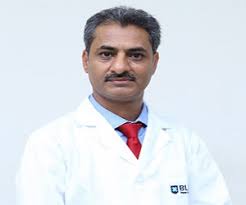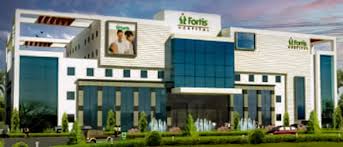Urology
Hydrocele Bilateral
Hydrocele Bilateral
Hydrocele Bilateral Treatment in India offers advanced and affordable solutions for fluid buildup around both testicles. Expert urologists ensure safe and effective recovery for patients.
Bilateral Hydrocele
- A hydrocele is a disorder in which the fluid accumulates in the thin sheath around testicles causing the scrotum to swell.
- Bilateral hydrocele refers to the fact that fluid builds up on the two sides of the scrotum, or on either side of the testicles.
- It is generally painless and harmless, yet big hydroceles may be painful, heavy or aesthetically displeasing.
Bilateral Hydrocele Treatment
Management of bilateral hydrocele varies according to age, signs and size of the hydroceles:
Retrospective (Observation) Management
- Apposite, small, painless hydroceles.
- Congenital hydrocele that may resolve naturally, which is often seen in infants, can be treated with the method.
- Should be monitored frequently to detect size or symptoms increase.
- Advantages: Non-surgical, non-invasive.
- Cons: Hydrocele could be persistent or increase in size; no therapy of symptomatic or large hydroceles.
Aspiration
- Removal of fluid in the hydrocele with a needle.
- It may be used together with sclerotherapy (injection of a substance to prevent re-accumulation of the fluid).
- Advantages: Minimal invasive, fast process.
- Cons Disadvantages: high recurrence rate; not a favorite as a long-term solution.
Surgery (Hydrocelectomy)
The ultimate treatment of bilateral hydrocele is surgery. Types of Hydrocelectomy:
Open Hydrocelectomy
- Cutting done into the lower abdomen or the scrotum.
- The hydrocele sac is removed or everted (inside out).
- Fluid is removed; sac repaired to avoid reoccurrence.
Minimally Invasive/ Laparoscopic Hydrocelectomy
- Less postoperative pain, fast healing, small incisions.
- Typically used in case of large or recurring hydroceles.
Indications for Surgery:
- Huge hernias that result in discomfort or heaviness.
- Chronic hydrocele in children older than 12 months.
- Mobility or activities involvement.
- Re-occurrence following aspiration.
- Cosmetic concerns.
Recovery:
- Normal activities normally take 1-2 weeks.
- Post-surgery swelling and bruising are minor.
- The majority of patients are able to get back to light activities in a few days.
Post-Treatment Care
- Wear support underwear to decrease swelling.
- Do not lift heavy or engage in strenuous activity - 2-3 weeks.
- Check infection (redness, fever, too much pain).
Bilateral Hydrocele Surgery
Bilateral hydrocele surgery or bilateral hydrocelectomy is a final operation to excise fluid-filled balloons around both testicles. It is reported in case of large, chronic, symptomatic or interfering hydroceles.
Types of Bilateral Hydrocelectomy:
Open Hydrocelectomy
Procedure:
- Holes are made in each side of the scrotum.
- The fluid is debrided and everted or the hydrocele sac is removed.
- Scrotal tissue undergoes a process of repair in order to avoid recurrence.
- Benefits High success, low recurrence.
Laparoscopic / Minimally Invasive Hydrocelectomy
- Procedure: Minimal incisions and camera-assisted excision or fixation of sacs of hydrocele.
- Benefits: Reduced pain after the operation, reduced healing time, reduced scarring.
- Usually used in: Large, recurrent or complex hydroceles.
Surgical Procedure
- Anaesthesia: Local, regional, or general anaesthesia
- Duration: 30–60 minutes per side
Steps:
- Patient positioned supine.
- Incision over the hydrocele.
- Hydrocele sac ruptured and discharged.
- Sac is either removed (excision) or turned inside out (eversion).
- Suture of suture of testicles.
- Dressings; supportive underwear desired.
Recovery
- Hospital admission: Typically the same-day discharge or overnights.
- Go back to light activities: 3-5 days.
- Going back to the normal activity/work: 1-2 weeks.
Postoperative care:
- Wear scrotal support
- Ice packs to reduce swelling
- Nobody should be subjected to intense activity within 2-3 weeks.
- Keep watch of infection, bleeding or recurrence.
Bilateral Hydrocele Causes
Hydrocele is fluid collection surrounding the testicles and the presence of it in both sides is termed bilateral hydrocele. The reasons may be either congenital (since the birth) or acquired (developing later in life).
Congenital Causes
Incomplete closure of processus vaginalis:
- In infants, the passage through which the abdominal cavity is linked to the scrotum can fail to close down leading to the accumulation of fluid.
- Frequently diagnosed during the initial year of life or at birth.
- Most spontaneously recovers in 1-2 years in children.
Acquired Causes
Bilateral hydroceles acquired later in life may be caused by:
Infections
- Epididymitis or orchitis (infection of epididymis or testis)
- May result in the development of fluid due to infection.
- May either be connected with pain, redness, or fever.
Trauma or Injury
- Direct trauma of the scrotum or testicles.
- Results in swelling and fluid buildup.
Post-Surgical Complications
- Proceeding on after hernia repair or other scrotal/testicular surgery.
- Lymphatic disruption sometimes leads to the development of hydrocele.
Testicular Tumors
- On bizarre occasions, hydrocele could develop as a secondary effect to the underlying testicular malignancy.
Age-related Causes
- Hydrocele may also be caused by fluid imbalance or chronic inflammation in older men.
Systemic conditions (Rare)
- Fluid could be accumulated in other body parts such as the scrotum and this could be a result of heart failure, kidney disease, or liver cirrhosis.
Bilateral Hydrocele Symptoms
A bilateral hydrocele is the condition in which fluid is filled around both the testicles and this leads to swelling and discomfort in the testicles. The symptoms may be different depending on the size of the hydroceles and the presence of any underlying condition.
Common Symptoms
Both-sided scrotal swelling
- The most obvious symptom.
- Scrotum can be soft, smooth and fluid.
The scrotum can be heavy or full
- A feeling of drag, or pressure, particularly during walking or standing.
Discomfort or mild pain
- Light in nature and can be felt only in the presence of large hydroceles.
- Physical activity or trauma may increase pain.
Development in size of the scrotum with the course of time
The swelling can progressively grow weeks or months.
Painless swelling
- Majority of hydroceles especially congenital ones are painless.
Less Common Symptoms
- The inability to move or walk because of huge hydroceles.
- Warmth or redness in case of infection or inflammation.
- Transillumination (illuminating through the scrotum depicts fluid, not tissue)
- Associated symptoms of underlying causes such as fever, urinary problems, or testicular mass rarely occur.
Factors Affecting Bilateral Hydrocele Surgery Cost
Indian bilateral hydrocele surgery cost depends on a number of factors. The following is a breakdown to assist you to comprehend the major factors that affect the total cost:
Type of Surgical Procedure
- Open Hydrocelectomy: Less expensive
- Laparoscopic Hydrocelectomy: Moderate
- Laser Hydrocelectomy: More expensive
Hospital Location
- Tier 1 Cities (e.g., Delhi, Mumbai, Chennai): There are increased costs as a consequence of advanced facilities and also increased living costs.
- Tier 2-3 Cities: Relatively inexpensive.
Surgeon's Expertise
- Best-trained urologists or experts might be more costly which can be due to their proficiency and status.
Hospital Type
- Private Hospitals: These are usually costly but have better-developed care and facilities.
Pre-operative and Post-operative Care
- Instant diagnosis (e.g. ultrasound, blood tests), medications, and subsequent visits.
Room Category
- Prices are different depending on the kind of room selected (general ward, semi- private, or private rooms).
Anaesthesia Type
- Local Anaesthesia: cheaper.
- General Anaesthesia: It is more expensive since it involves extra monitoring and machinery.
Best Hospitals for Bilateral Hydrocele Surgery in India
- Artemis Hospital, Gurgaon
- Medanta-The Medicity, Gurgaon
- Fortis Memorial Research Institute, Gurgaon
- Max Hospital, Saket
Conclusion
Bilateral hydrocele is a harmless disorder, which is a collection of fluid around both testicles and produces swelling, heaviness, or pain. Although usually painless, large or chronic hydroceles can impair mobility, day-to-day functions or cosmetics. Congenital (in children) or acquired (in adults) as a result of infection, trauma, surgery or infrequent tumors. The scrotal swelling is painless, heavy, slow to enlarge, and painful, sometimes. Scrotal ultrasound, physical examination, and transillumination. Prices are determined depending on the procedure, hospital, expertise of surgeons, anaesthesia, and location. It generally takes 1-2 weeks to recover and in most patients the outcomes are excellent. Bilateral hydrocele is usually treated with a surgery that is curable and those affected usually recover their swelling and discomfort. Early diagnosis makes sure that any underlying disorders, like infection or testicular pathology, are managed early.
Why Choose GetWellGo for Bilateral Hydrocele Surgery?
GetWellGo is regarded as a leading supplier of healthcare services. We help our foreign clients choose the best treatment locations that suit their needs both financially and medically.
We offer:
- Complete transparency
- Fair costs.
- 24 hour availability.
- Medical E-visas
- Online consultation from recognized Indian experts.
- Assistance in selecting India's top hospitals for Bilateral Hydrocele Surgery.
- Expert Urologist with a strong track record of success
- Assistance during and after the course of treatment.
- Language Support
- Travel and Accommodation Services
- Case manager assigned to every patient to provide seamless support in and out of the hospital like appointment booking
- Local SIM Cards
- Currency Exchange
- Arranging Patient’s local food
FAQ
What is the diagnosis of bilateral hydrocele?
- Physical: Soft, light-transilluminating, fluid filled swellings.
- Ultrasound: Makes sure that the fluid is collected and eliminates hernia and tumor of the testicles.
- Blood/ urine tests: In case of suspicion of infection.
Is a hydrocele self-limiting?
- In children: A large number of congenital hydroceles disappear between 1 and 2 years of age.
- In adults: Self-limiting hydroceles are uncommon; symptomatic or chronic hydroceles typically need to be surgically removed.
Is it painful with bilateral hydrocele surgery?
- This is done under anaesthesia (local, regional or general) and therefore the actual operation is painless. The pain after the surgery is generally not severe and can be treated with painkillers.
What is success rate of hydrocelectomy?
- Open hydroceletomy: >95 percent success, low recurrence.
- Minimally invasive/laparoscopic: equal success, quicker recovery, scars are smaller.
Is there a recurrence of hydrocele following an operation?
- Recurrence is very uncommon, though may happen in case the sac is not completely removed or repaired. Recurrence will be reduced by proper surgical technique.
TREATMENT-RELATED QUESTIONS
GetWellGo will provide you end-to-end guidance and assistance and that will include finding relevant and the best doctors for you in India.
A relationship manager from GetWellGo will be assigned to you who will prepare your case, share with multiple doctors and hospitals and get back to you with a treatment plan, cost of treatment and other useful information. The relationship manager will take care of all details related to your visit and successful return & recovery.
Yes, if you wish GetWellGo can assist you in getting your appointments fixed with multiple doctors and hospitals, which will assist you in getting the second opinion and will help you in cost comparison as well.
Yes, our professional medical team will help you in getting the estimated cost for the treatment. The cost as you may be aware depends on the medical condition, the choice of treatment, the type of room opted for etc. All your medical history and essential treatment details would be analyzed by the team of experts in the hospitals. They will also provide you with the various types of rooms/accommodation packages available and you have to make the selection. Charges are likely to vary by the type of room you take.
You have to check with your health insurance provider for the details.
The price that you get from GetWellGo is directly from the hospital, it is also discounted and lowest possible in most cases. We help you in getting the best price possible.
No, we don't charge patients for any service or convenience fee. All healthcare services GetWellGo provide are free of cost.
Top Doctors for Urology
Top Hospitals for Urology
Contact Us Now!
Fill the form below to get in touch with our experts.







